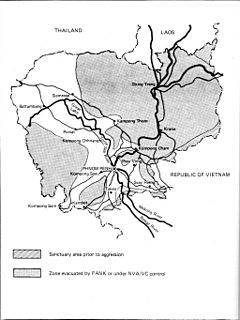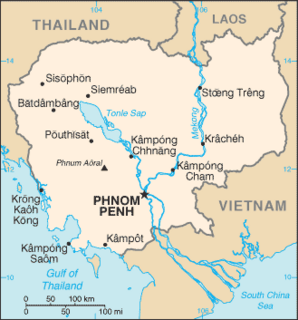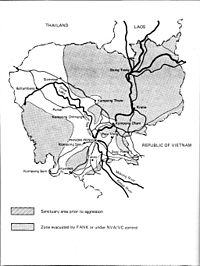
The People's Army of Vietnam, also known as the Vietnamese People's Army (VPA), is the military force of the Socialist Republic of Vietnam. The PAVN is a part of the Vietnam People's Armed Forces and includes: Ground Force, Navy, Air Force, Border Defence Force, Coast Guard, Cyberspace Operations, and Mausoleum Defence Force. However, Vietnam does not have a separate Ground Force or Army branch. All ground troops, army corps, military districts and specialised arms belong to the Ministry of Defence, directly under the command of the Central Military Commission, the Minister of Defence, and the General Staff of the Vietnam People's Army. The military flag of the PAVN is the flag of the Socialist Republic of Vietnam, with the words Quyết thắng added in yellow at the top left.

The Khmer Republic was the pro–United States military-led republican government of Cambodia that was formally declared on 9 October 1970. Politically, the Khmer Republic was headed by General Lon Nol and Prince Sisowath Sirik Matak that took power in the 18 March 1970 coup against Prince Norodom Sihanouk, then the country's Chief of State.

The Cambodian Civil War was a civil war in Cambodia fought between the forces of the Communist Party of Kampuchea against the government forces of the Kingdom of Cambodia and, after October 1970, the Khmer Republic, which had succeeded the kingdom.

The Khmer National Armed Forces were the official armed defense forces of the Khmer Republic, a short-lived state that existed from 1970 to 1975, known today as Cambodia. The FANK was the successor of the Royal Khmer Armed Forces which had been responsible for the defense of the previous Kingdom of Cambodia since its independence in 1954 from France.

The Cambodian campaign was a brief series of military operations conducted in eastern Cambodia, which was officially a neutral country, in 1970 by South Vietnam and the United States as an extension of the Vietnam War and the Cambodian Civil War. Thirteen major operations were conducted by the Army of the Republic of Vietnam (ARVN) between 29 April and 22 July and by U.S. forces between 1 May and 30 June.

Operation Chenla I or Chenla One was a major military operation conducted by the Khmer National Armed Forces (FANK) during the Cambodian Civil War. It began in late August 1970 and ended in February 1971, due to the FANK High Command's decision to withdraw some units from Tang Kauk to protect Phnom Penh after Pochentong airbase was attacked.
The Battle of Kampot was a major battle of the Vietnam War, also a part of the Cambodian Civil War. From February 26 to April 2, 1974, Cambodian government troops battled Khmer Rouge guerillas for the control of Kampot city.

The Sihanouk Trail was a logistical supply system in Cambodia used by the People's Army of Vietnam (PAVN) and its Viet Cong (VC) guerillas during the Vietnam War (1960–1975). Between 1966 and 1970, this system operated in the same manner and served the same purposes as the much better known Ho Chi Minh Trail which ran through the southeastern portion of the Kingdom of Laos. The name is of American derivation, since the North Vietnamese considered the system integral to the supply route mentioned above. U.S. attempts to interdict this system began in 1969.
Operation Freedom Deal was a United States Seventh Air Force interdiction and close air support campaign waged in Cambodia, a neutral country, between 19 May 1970 and 15 August 1973, as an expansion of the Vietnam War, as well as the Cambodian Civil War. Launched by Richard Nixon as a follow-up to the earlier ground invasion during the Cambodian Campaign, the initial targets of the operation were the base areas and border sanctuaries of the People's Army of Vietnam (PAVN) and the Viet Cong (VC). As time went on most of the bombing was carried out to support the Cambodian government of Lon Nol in its struggle against the communist Khmer Rouge. The area in which the bombing took place was expanded to include most of the eastern one-half of Cambodia. The bombing was extremely controversial, and led the U.S. Congress to pass the War Powers Resolution.
The earliest traces of armed conflict in the territory that constitutes modern Cambodia date to the Iron Age settlement of Phum Snay in north-western Cambodia.
The Khmer Special Forces, also designated 'Khmer SF' for short or Forces Speciales Khmères (FSK) in French, were the elite Special Operations unit of the Khmer National Armed Forces during the 1970-75 Cambodian Civil War.

The Cambodian Marine Corps or Corps de Fusiliers-Marins Khmères (CFMK) in French, were the Naval Infantry branch of the Khmer National Navy during the 1970-75 Cambodian Civil War.

The Khmer Air Force, commonly known by its americanized acronym KAF was the air force component of the Khmer National Armed Forces (FANK), the official military of the Khmer Republic during the Cambodian Civil War between 1970 and 1975.

The Khmer National Army, commonly known as the "Cambodian Army", was the Land Component of the Khmer National Armed Forces (FANK), the official military of the Khmer Republic during the Cambodian Civil War between 1970 and 1975.
The Fall of Phnom Penh was the capture of Phnom Penh, the capital of the Khmer Republic, by the Khmer Rouge on 17 April 1975, effectively ending the Cambodian Civil War. At the beginning of April 1975, Phnom Penh, one of the last remaining strongholds of the Khmer Republic, was surrounded by the Khmer Rouge and totally dependent on aerial resupply through Pochentong Airport. With a Khmer Rouge victory imminent, the US government evacuated US nationals and allied Cambodians on 12 April 1975. On 17 April the Khmer Republic government evacuated the city, intending to establish a new government center close to the Thai border to continue resistance. Later that day the last defences around Phnom Penh were overrun, and the Khmer Rouge occupied Phnom Penh.
Project Copper was a coordinated military action undertaken by the Kingdom of Laos and the Khmer Republic from 1 January–May 1971. It used U.S. Department of Defense (DOD) funds channeled through the Central Intelligence Agency to train three Cambodian battalions to interdict the Sihanouk Trail before it joined the Ho Chi Minh Trail. Committed to battle in southern Laos on 1 January 1971, one battalion deserted the battlefield, a second one mutinied during training, and a third had to be repurposed after suffering 80 casualties. By late January, the project was temporarily suspended.
The Battle of Hồng Ngự took place from March to 4 May 1973 when North Vietnamese forces attacked the border town of Hồng Ngự in Dong Thap Province in order to interdict supply convoys into Cambodia. The attack was defeated by South Vietnamese forces assisted by United States bombing of North Vietnamese base areas in Cambodia.
Operation Cuu Long 44-02 was an operation during the Vietnam War conducted by South Vietnamese and Cambodian forces from 13-25 January 1971 to reopen Route 4 in Cambodia.








